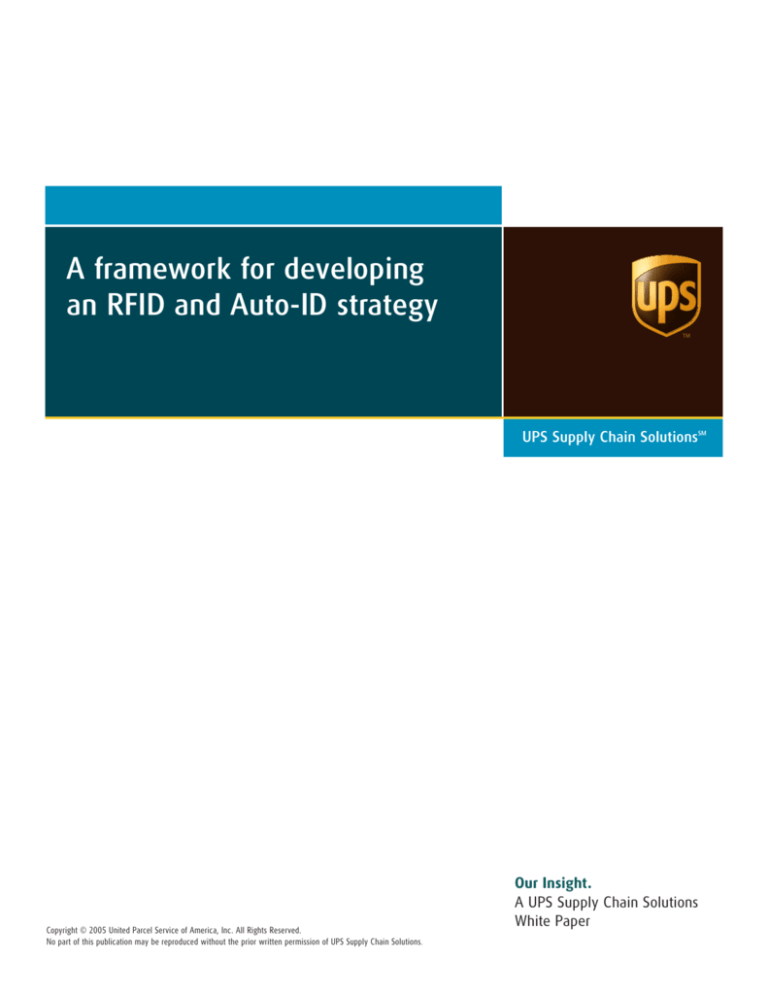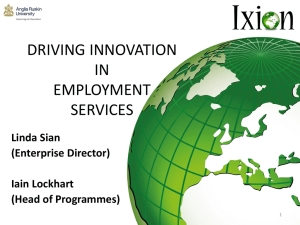
A framework for developing
an RFID and Auto-ID strategy
UPS Supply Chain SolutionsSM
Copyright © 2005 United Parcel Service of America, Inc. All Rights Reserved.
No part of this publication may be reproduced without the prior written permission of UPS Supply Chain Solutions.
Our Insight.
A UPS Supply Chain Solutions
White Paper
Witness how the headlines are getting more
crowded with RFID proclamations and predictions
that are causing all concerned to ponder:
The success or failure of a
given Auto-ID strategy is
often determined before the
project begins.
• The costs and risks of doing nothing (the defensive approach)
• The costs and rewards of minimum compliance in meeting
market dictates
• The total value creation potential an enterprise can receive
through this enabling technology
• The total value a trading industry can create through this
enabling technology
• An implementation strategy that might combine multiple
courses of action in parallel fashion
• How broad the strategy should be:
– Product centric
– RFID centric
– Post RFID
Separating the headlines from the real potential is difficult but
important to address sooner rather than later. Implementing the
technology may be a future step, but getting the facts is a task for
the near term. In a related white paper, “Demystifying RFID: An
overview of the promise and the pitfalls,” UPS Supply Chain
Solutions identified macro-level opportunities and issues with
RFID in the supply chain, and examined the business case and
pilot activities for determining its value.
In this paper, UPS Supply Chain Solutions looks at why it is so
important for companies to develop a holistic Auto-ID strategy, not
simply an RFID strategy. While broader in scope, this approach is
most appropriate for how a family of solutions can work together to
streamline or resolve issues across multiple business processes. Nor
does it presume that RFID is necessarily the answer before the
problem is defined and the right solution fit can be determined.
As a backdrop to developing the Auto-ID strategy, consider the
following guiding principles:
• Understand in detail what is absolutely demanded by the
markets’ major players and understand the consequences of
non-compliance
• Determine if this enabling technology will improve business
processes for the root causes that impact enterprise value
levers
• Establish if the technology will impact decision-making
capability within the organization that manages these
processes
UPS Supply Chain Solutions
1
• Evaluate the likelihood of regulators to add future
requirements that can best be dealt with by this technology
• Base the business imperative in deciding the strategy and
implementation plan on facts and trends with the business
cases and management of risks driving these decisions.
Also included in this white paper is the application primer “A Day
in the Life of RFID” which illustrates key areas of the supply chain
that might benefit from its unique characteristics. This primer can be
a “strawman” for insights into how business processes might
be re-engineered in the future. Deciding whether or how these
processes can be modeled in the supply chain is the domain of the
Auto-ID strategy team.
Getting started: developing an Auto-ID strategy
The success or failure of a given Auto-ID strategy is often determined
before the project begins. Great execution cannot make up for poor
strategic planning, and leadership must set the proper agenda for
success. UPS Supply Chain Solutions offers the following key success
factors for consideration early in the strategic planning process for
Auto-ID:
• Top management support is essential and leadership must have
the commitment to define the strategy and provide necessary
resources.
• Qualified team members are those with intimate knowledge of
business processes, knowledge of the technology enablers, and
the ability to envision how the processes might be improved.
• The lack of comprehensive facts and data should not be the
cause of team paralysis. Informed opinions will be required for
reaching proper conclusions.
• Company mission statements and business strategies do not
always provide guidance as to how operational strategies
should be formed. In most cases leadership must provide the
necessary clarity and guidance.
• Deployment decisions should be made during the pilot to
allow sufficient time for lessons learned.
Often strategists give the advice to “begin with the end in mind.”
This is sound logic, but how does one settle on what the “end”
should be? This is where leadership must be organized in expressing
a vision of the future state, and defining the alternatives that will
result in achieving this vision. The development of this strategy
should be led at the executive level and supported by a steering
committee. As with all projects, the effort should have a clearly
defined timeline, set of deliverables and a project charter that will
answer the question of “how do we know when we are done?”
UPS Supply Chain Solutions
2
The following guidelines can serve as an early framework for
companies considering an Auto-ID strategy:
Process
• The strategy must be holistic, spanning the length of the
enterprise and the breadth of the supply chain.
• All processes that require data should be considered in-scope
for re-design, before being taken out-of-scope.
• Design of processes should focus upon how to automate
decisions and tasks through use of data.
Organization
Payback should be
considered over a long-term
horizon.
• Enabling technologies will impact people. Proper change
management diligence will be required for successful process
and technology re-engineering.
• Auto-ID has great potential for process measurement. These
new capabilities must be integrated into performance and
reward systems for alignment with company objectives.
Technology
• Auto-ID should not be a technology play — it should be an
information play that is focused on business intelligence and
the ability to execute.
• Some level of redundancy is desirable to mitigate technology
risks and the potential costs of process failure.
Financial
• Decisions should not be purely ROI-based. Strengthening
internal capabilities and external supply-chain relationships
must be part of the equation.
• Payback should be considered over a long-term horizon —
home run projects are too few and far between. Base hits are
the key to supply chain success.
The journey should begin with executive representation from major
process areas such as customer service, product development,
production, distribution and accounting. The comprehensiveness of
the vision is important in deciding how the company might
differentiate products and services, enhance customer relationships,
and wring out latent inefficiencies in the supply chain.
The components of an Auto-ID strategy include the future state
vision, business process assessment, and the business case for AutoID. While these are ordered phases of work, they can and should
overlap “at the ends” to compress the overall cycle time from vision
through pilot completion (see Figure 1).
UPS Supply Chain Solutions
3
Figure 1: UPS Consulting Auto-ID strategy framework
Future state vision
This vision should focus upon how the company will operate
differently when infused with new data, and how this data can be
converted to useful information that adds value. The vision should:
• Have linkage to the overall corporate strategy or mission
statement
• Direct behavior; without directing behavior the vision serves
little purpose
• Be longer-term, spanning 5-10 years or more in most cases
• Respect differentiators that allow firms to grow and sustain
margins
• Be achievable, given resource and technology constraints
• Include a vivid description of how the firm will utilize data to
add value.
Business process assessment and future process design
Closed loop versus open network strategy
The linkage of a future state vision to a broader strategy may point
to whether or not the solution will be closed loop (within the four
walls) or an open network (shared among multiple parties) as
UPS Supply Chain Solutions
4
Auto-ID can foster the flow
of information, goods and
commerce for multiple
supply chain partners who
are willing to share data and
link business processes.
envisioned by EPC Global, a member-driven organization comprised
of leading firms and industries which is spearheading the development
of industry-driven standards for the Electronic Product Code (EPC)
Network to support the use of Radio Frequency Identification
(RFID) in today’s fast-moving, information rich trading networks.
The closed loop model has been successfully used for internal asset
visibility, sortation, process automation and many other uses. An
open network model used for customer and supplier collaboration
can yield significant benefits and should be of primary consideration
for a holistic Auto-ID strategy. Auto-ID can foster the flow of
information, goods and commerce for multiple supply chain partners
who are willing to share data and link business processes.
Process analysis
Often, successful companies that control their existing processes
through information do not later review them for improvement
opportunities. Left alone, the current processes stabilize into
predictable patterns, and variations are managed on a continuing
basis. If firms are truly to benefit from Auto-ID, they must re-think
these processes and introduce change.
It is surprising how often the process of documenting current work
methods uncovers hidden variations from established standards or
finds that there is no standard process. This discovery effort is the
starting point for business process assessment and it often highlights
manual tasks and handoffs that may be prime candidates for
automation through Auto-ID. Further, human error can be the cause
of inefficiency even when a good process is in place; Auto-ID may
dramatically reduce this potential error.
Key questions to ask when evaluating a given business process:
• What manual tasks can be automated?
• Where are the decision points and can they be systematized?
• What data or information could be captured and utilized to
foster automation or throughput?
• Can efficiency or accuracy be gained in the downstream
processes by changing this process?
• Could the process benefit from having information available
near real-time?
• What information must reside on the asset and should it be
static or dynamic information?
• What information or other safeguards could be introduced to
prevent errors?
UPS Supply Chain Solutions
5
• Does the process span geographic boundaries that might
impact the proposal?
• How could customers and trading partners benefit from this
information?
• What process-centric data allows better management of the
linked processes?
Typical improvement opportunities:
If firms are truly to benefit
from Auto-ID, they must rethink these processes and
introduce change.
• Reduction in cycle time (start-to-stop times for a given
process)
• Improvement in accuracy (actual versus planned results)
• Reduction of labor (time required for human inputs)
• Improvement in efficiency (work inputs compared to the
outputs)
• Improvement in customer interface (how customers could
benefit from the information).
The output of the business process assessment and future process
design should include a set of opportunities with operating
assumptions that can be further investigated in the business case
phase. The most difficult component of the Auto-ID strategy is likely
to be the future process design. The application examples at the end
of this paper offer a glimpse into how these processes might be
enabled by Auto-ID.
The business case for Auto-ID
Once the strategy team has developed an initial vision and evaluated
business processes for potential benefit, the focus should shift to the
business case. It will likely be necessary to charter a sub-team for
developing the business case for Auto-ID with feedback into the
steering committee.
As noted in Figure 1, the outputs of the business process assessment
and future process design are the inputs for the business case. It is
desirable to have some overlap in the phases leading up to the
business case. Such overlap can ensure common understanding,
reduce time-to-completion and allow resource sharing.
UPS Supply Chain Solutions has developed the following Auto-ID
business case methodology to guide the determination of the
business value of these technologies and processes. This approach
presumes that team members are versed in the benefits, costs and
issues associated with various Auto-ID options (linear bar-codes, 2-D
codes and RFID).
UPS Supply Chain Solutions
6
Figure 2: UPS Supply Chain Solutions Auto-ID business case methodology
The Auto-ID business case
requires disciplined
creativity in that values
must be assigned to new
process steps or the
displacement of existing
ones.
The Auto-ID business case requires disciplined creativity in that
values must be assigned to new process steps or the displacement of
existing ones. Will the new combination result in greater profits for
the enterprise, or is there an opportunity cost to be considered?
What are customers and suppliers doing that might impact our
decision? These are important questions that the business case
should answer in addition to the obvious ROI question. By
sampling the costs, benefits, dos and don’ts of the broader
implementation, the pilot project can be very helpful in determining
some of the answers.
The business case and pilot should result in a set of recommendations
for both the short-term and long-term (5-10 years).
Summary
Executive leadership owns the decision for the Auto-ID strategy and
must decide if the new capabilities or foundation for new capabilities
justify the effort required. ROI should be a major but not the sole
criterion for decisions. The strategy decision should be based upon
where the company will be in the future, not where it is now, nor
where it has been. Getting the answers to strategic questions is a
continuum, and companies need to adopt strategies of design —
deliberate action to anticipate probable outcomes and adjust
capabilities accordingly.
UPS Supply Chain Solutions
7
UPS Supply Chain Solutions will continue offering thought
leadership on RFID and Auto-ID throughout 2004 in a series of
related white papers to help companies navigate the complex supply
chains of the present and future.
Application Primer: A day in the life of RFID
The current industry focus on meeting RFID mandates will
accelerate the adoption of the technology, as did mandates for EDI
and bar-coding decades ago. The mandates for pallet and case
tagging are also causing firms to examine how they use information
to operate their businesses beyond the minimum requirements for
compliance. For this effort, companies need to evaluate automation
and error-proofing opportunities from inception through closeout of
business processes. The examples we present below may assist in
determining where these applications could add value.
Illustration # 1 A day in the life of the factory
The following applications are not limited to a factory environment
and are not an exhaustive list of options for Auto-ID. Rather, they
are presented as ideas to stimulate creative thought around the use
of supply chain data in business processes.
Companies should be looking for Auto-ID not only to reduce costs,
but to grow revenue. How can this be done? One major opportunity
for companies is to improve the customer experience through
leveraging information. The increased visibility that Auto-ID can
provide to the supply chain can be a differentiator for many firms
UPS Supply Chain Solutions
8
that are creative in harnessing information value. Spoken plainly,
companies should find a way to improve customer relationships.
Some examples might include:
• Providing order status information proactively — don’t wait
for “where’s my order?” A status notification triggered by
reading a tag at a specific interval is possible and may
strengthen relationships among trading partners.
• Using exception management techniques (based upon supply
chain data) to prevent service failures
• Using proactive service recovery — contact the customer
before they are affected by the service issue
• Providing expedited fulfillment options — based upon
knowledge of where the inventory is right now
• Collaborative program management — improve forecast
accuracy based on actual data, reduce cycle time based upon
true measurements, and improve decisions based upon facts
and data
• RFID enabled products — for parts maintenance records, anticounterfeiting, sensor coupling for temperature, humidity and
other environmental monitoring, etc.
Illustration 2: A day in the life of the warehouse
In addition to the scenarios below, warehouse operations with or
requiring significant search time for parts, inventory, equipment or
other assets could benefit from RFID. Often, this search time is not
measured and can represent a major embedded process cost. The
potential of knowing where things are at all times is a prospective
RFID application for reducing or eliminating search time.
UPS Supply Chain Solutions
9
Finding the value of Auto-ID requires significant effort and
willingness to change procedures in fundamental ways.
Like other types of business infrastructure, the payback for this
technology may be longer term and require large-scale change.
About the Author
Michael Sullivan is a principal at UPS Supply Chain Solutions and is
based in Georgia. He can be reached at msullivan@ups-scs.com.
To learn more about how our experience in supply chains and
consulting can help your business, please contact us:
1.800.742.5727 U.S.
1.678.746.4365 International
Visit us at ups-scs.com
About UPS Supply Chain Solutions
By aligning a client’s business strategies with its operating processes,
UPS Supply Chain Solutions can create high-performance supply chains
that from inception to implementation generate real, hard-number
values and quick benefit realization. This distinguishing capability, our
experience in solving real-world challenges, and the resources of UPS
enable us to set strategies, design and build solutions as well as
implement, operate, manage and synchronize your world of commerce.
Copyright © 2005 United Parcel Service of America, Inc. All Rights Reserved. WP.SCS.CS.636
No part of this publication may be reproduced without the prior written permission of UPS Supply Chain Solutions.
UPS Supply Chain Solutions
10







